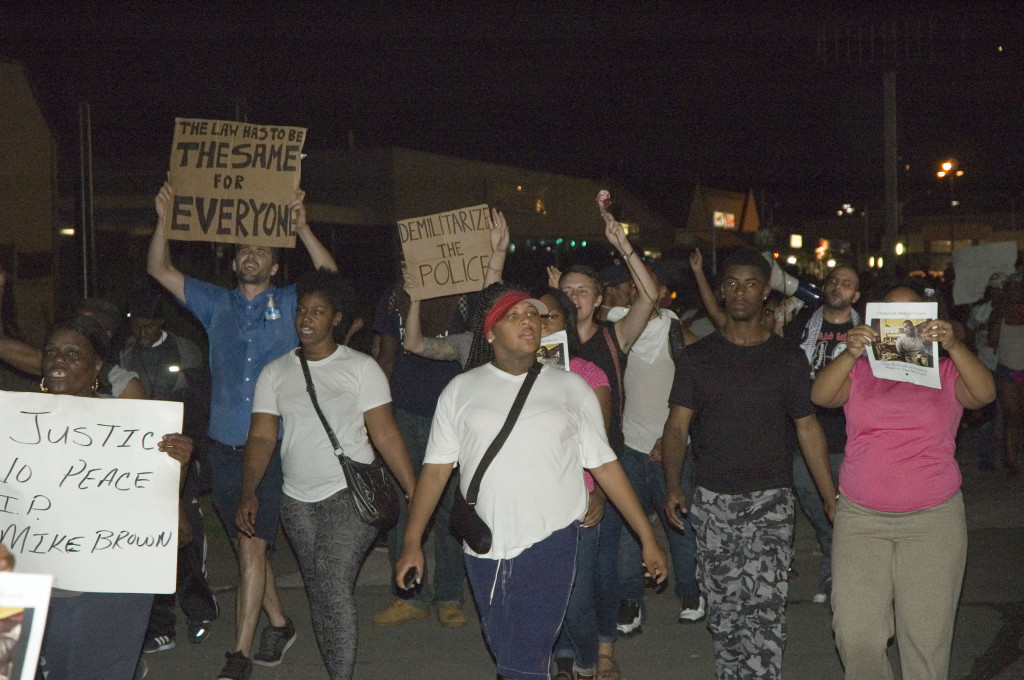
Protesters hit the streets of Ferguson, M.O. on August 19. Image: peoplesworld (Flickr)
As protests against the handling of Michael Brown’s death rage on in Ferguson, M.O., the scene, as well as its cause and its location, has scholars and the broader public pointing to the various ways the brutal death of a young black male is a direct legacy of America’s racially-divided past, with poignant resonance with specific moments in history. The demonstrations are a call for justice after the fatal shooting of an unarmed 18-year-old black male by a police officer, and the subsequent insufficient response by both local and federal authorities to hold Officer Darren Wilson accountable.
At the root of the uproar is the grave understanding that, as Harvard professor Annette Gordon-Reed summed it up, “Black lives are worth less than white lives.”
Reed, as well as others, shows the connection between this current incident and the bigger picture of the oppression experienced by black Americans for centuries: “There’s also the realization that killing black people is allowable in ways that it’s not allowable to kill whites… this is a historical thing – this comes from slavery, this comes from Jim Crow, the aftermath of slavery and Reconstruction.”
If it’s tough to see how these throwbacks to history are relevant — vignettes many of us think of as relics of a time long gone when racism meant white hoods and burning crosses — all it takes is a close look at the series of events to see that black Americans still do not have same rights — the equal citizenship — as white Americans. They are often not regarded in the same way under many present-day policies.
What actually occurred in the moments before Brown’s death is still up for debate. But even with arguments such as self-defense being used to justify the six bullets fired by Officer Darren Williams (including two in the head), one thing is for sure: Brown and his family are entitled to an investigation and due process to, at the very least, question whether he was an innocent victim of murder.
When asked to speak about President Obama’s remarks following the events in Ferguson, Dr. Cornel West asked people to consider how race would alter the optics of Brown’s death:
“Once again, we have to deal with the vicious legacy of white supremacy. Once again, we have to raise the question: if our dear brother Michael Brown were a precious white youth killed in Newtown, C.T., or a precious Jewish youth killed in Westchester, N.Y., would the President, Congress, legal systems respond in the same way as him being a precious black brother in Ferguson, St. Louis? And I think we know the answer. The American system is an abysmal failure when it comes to keeping track of the humanity of black poor, and in this case black poor youth.”
When it comes to the notion of citizenship and who deserves protection under the law, multiple historians reflected on the milestone 1857 Dred Scott v. Sanford case. Dred Scott was a slave from Virginia who was moved to Missouri, which was at the heart of the national debate over slavery. Scott sued for his freedom in a St. Louis court – and lost. The final decision, written by Chief Justice Roger B. Taney and considered to be one of the worst in the history of the Supreme Court, read that blacks were, “beings of an inferior order, and altogether unfit to associate with the white race, either in social or political relations, and so far inferior that they had no rights which the white man was bound to respect.”
Taney asserted that the Declaration of Independence’s statement that all men are created equal very clearly did not pertain to the African race, neither slaves nor their descendants, and that “persons of color, in the judgment of Congress, were not included in the word citizens.”
That was a long time ago, of course, with blacks being overtly declared as citizens in 1868 with the Fourteenth Amendment to the Constitution. But the parallels between now and then tell a different story. The policing of black bodies on the streets of America, some argue, are modern-day lynchings. Young black males, in particular, are marginalized and targeted as criminals, suspected of violence when simply existing in their skin, and used as puppets in the War on Drugs and the militarization of local police forces.
The Dred Scott case, along with periods that followed it when blacks were technically free but had every reason to fear for their lives, left more than the bitter taste of strange fruit. It spelled out, in no uncertain terms, that America was not created equally for all men, and that all men were not created equal in America. That concept of two Americas is all too familiar to blacks in the U. S. today. And the town of Ferguson, part of St. Louis county, has its own dark relationship with this division.
Many media outlets are reporting on how the governing bodies in Ferguson in no way mirror the people: the suburban town with a population of 21,000 is 69 percent black, with its political power in the hands of nearly all white people. Mayor James Knowles, Gov. Jay Nixon, and Police Chief Thomas Jackson are white, along with five of the six City Council members. The school board has six white members, the seventh Hispanic. Most directly salient in this case, only three out 53 officers in the Ferguson Police Department are black. Moreover, blacks account for 86 percent of the traffic stops in the city, and 93 percent of the arrests after those stops. Earlier this year, the NAACP filed a civil rights complaint against the St. Louis County Police for racial profiling.
The implication of these numbers may be obvious to most, but what requires a deeper analysis is decades of enforced housing segregation in the area, which has led to stark wealth inequality between whites and blacks – the consequence being an underclass that America is quick to blame for its poverty. As Ta-Nehisi Coates has written about extensively this year, through exclusionary zoning tactics, mortgage fraud, contract-selling, red-lining, and the Federal Housing Authority’s refusal to insure loans taken out by people who lived near blacks, legislation made the ghetto public policy.
Present day St. Louis County and Ferguson are a result of these policies from much of the 20th century. The St. Louis metro area is ranked ninth out of America’s 50 most segregated between whites and blacks. Whites fled the city for the suburbs in the ‘50s, ‘60s, and ‘70s, which blacks couldn’t do because of restrictive covenants. Like many cities, the urban and inner suburban parts of the area of St. Louis, where Ferguson is located, are also poorer. As Bryce Covert put it at ThinkProgress, “Given that blacks have been shut out of buying homes, a huge source of wealth, and discriminatory practices depressed the values of those who did manage to buy houses, it’s no surprise that there continues to be a huge racial wealth gap.”
It’s no wonder that there is discontent in Ferguson. The tensions on the streets are not simply the result of a young black man being shot by a cop; they are a response to a system which is geared to create the circumstance in which a young black man can be shot by cop with impugnity.
In 1968, exactly 100 years after Congress adopted the Fourteenth Amendment to the Constitution, a study put forth by President Lyndon B. Johnson examined what was behind the nation-wide uprisings that took place from 1964 to 1967. The Kerner Commission concluded: “Our nation is moving toward two societies – one black, one white – separate and unequal.” A month later, protests erupted across the country after the assassination of Martin Luther King, Jr., including in St. Louis, M.O., where the National Guard was deployed and at least five people were killed. Somehow, this moment sparked by the killing of Michael Brown seems not so far off from that.
Drawing parallels once again to Dred Scott, who is buried in Calvary Cemetery on West Florissant Avenue just miles away from the protests, Kimberlé Crenshaw, professor of law at UCLA and Columbia University and founder of the African American Policy Forum, pointed to the attack on basic rights that is happening with the use of tear gas and rubber bullets on those organizing in resistance.
“Well, I have concerns in that it seems as though the only thing that really ripped Dred Scott away from history was massive uprising. One was a civil war, and then the next thing that happened was a civil rights movement. What would we think would happen if there was a civil rights movement now with the weapons of mass destruction that local officers have?… There are specific things that need to be done, and those don’t involve just asking boys to act better or for there to be mentors. There’s only so much you can do holding up your hands against structural and long-term racial problems, that Ferguson has clearly shown. This is the end of post-racialism. The question is, is it the beginning of something else?”
The hope among organizers and protestors on the ground in Ferguson, as well as those taking part in solidarity movements nationally, is that it is indeed the beginning of something else. The hope is for the ability to engage in civil disobedience peacefully, and to trust that the justice system will place equal value on all lives.
·
 Chaya Babu is a Blog Editor for The Brooklyn Quarterly as well as a writer for India Abroad and a number of other publications. Her work focuses on social issues and culture, and you can check our her musings on brown, feministy, identity politics at The Fobby Snob.
Chaya Babu is a Blog Editor for The Brooklyn Quarterly as well as a writer for India Abroad and a number of other publications. Her work focuses on social issues and culture, and you can check our her musings on brown, feministy, identity politics at The Fobby Snob.
